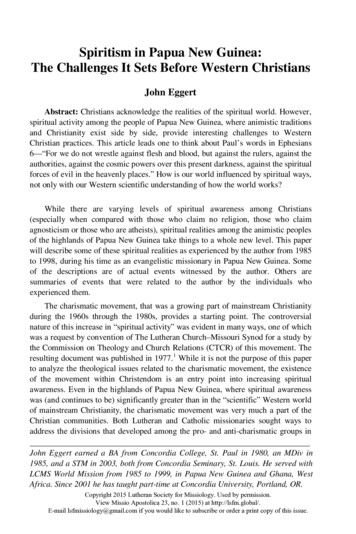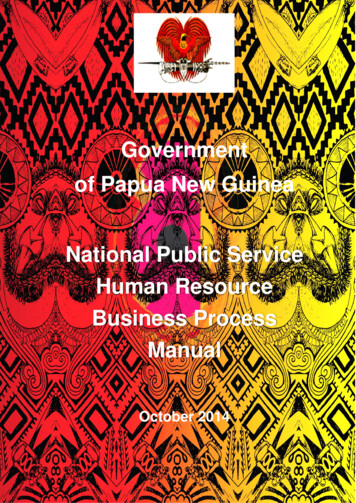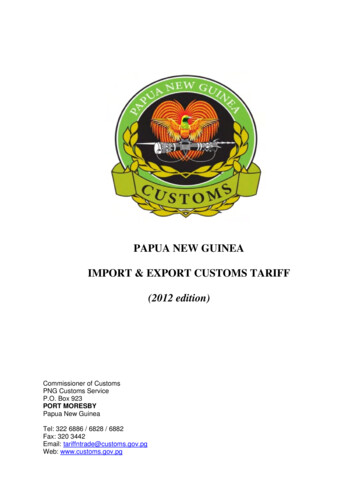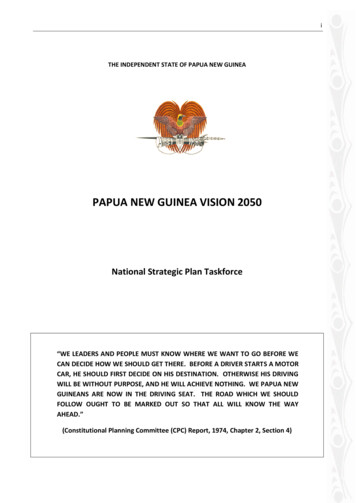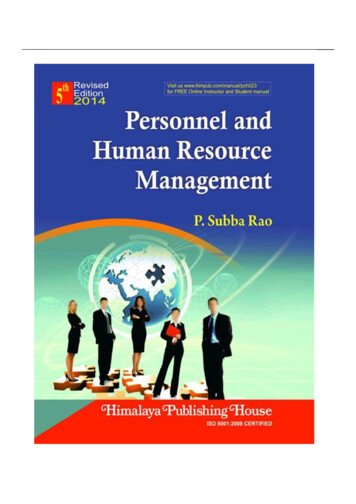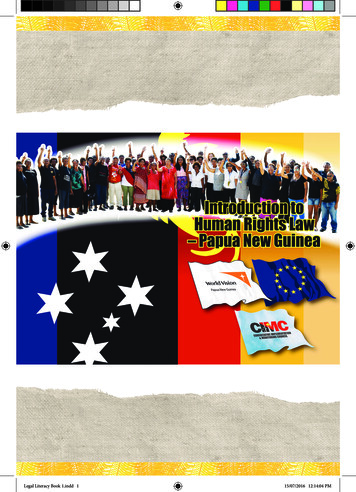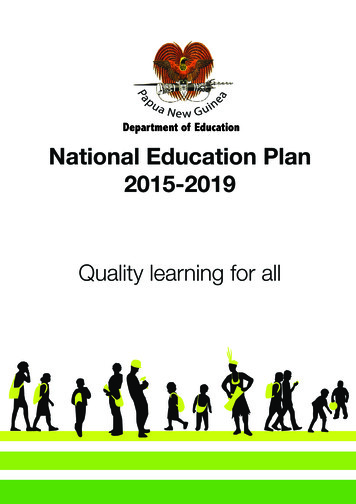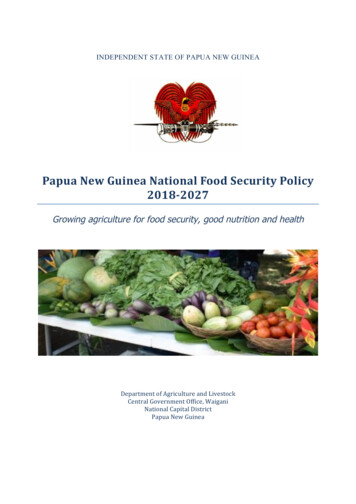
Transcription
Papua New Guinea National Food Security Policy 2018-2027INDEPENDENT STATE OF PAPUA NEW GUINEAPapua New Guinea National Food Security Policy2018-2027Growing agriculture for food security, good nutrition and healthDepartment of Agriculture and LivestockCentral Government Office, WaiganiNational Capital DistrictPapua New Guinea
Papua New Guinea National Food Security Policy 2018-2027ForewordThe National Goals and Directive Principles in our Constitutioncall for improvement in the level of nutrition and standard ofpublic health to enable our people to attain self fulfilment.However, some 40 years since the adoption of the Constitutionthe problem of malnutrition continues to be a significantimpediment in our nation’s health, social and economicdevelopment. The poor public health situation reflectsweaknesses in the country’s food and nutrition security whichis undermining our efforts to reach the Vision 2050 targets ofbeing a healthy, empowered, educated, happy population andthe placing of our country in the top 50 in the HumanDevelopment Index ranking.Food security is a basic human right. Ensuring our nation’s food security is fundamental for sustainablehuman and economic development and is central to social and political stability. The Papua New GuineaFood Security Policy 2018-2027 affirms our Government’s commitment to strengthening national foodsecurity to sustainably improve our people’s wellbeing and quality of lives in both the rural and urbanareas of the country.In terms food security and nutrition Papua New Guinea’s agriculture sector has special importance. Itcontinues to be the main source of food, employment and income for over 85 percent of the population,who mainly live in rural areas. Therefore, agricultural growth remains one of the best ways togenerate income for the poorest in in our country who need the most help buying nutritious food.Moreover, because of the prominent role our women play in food production and marketing, agriculturecan provide an important entry-point for enhancing women’s control and management of resources,knowledge and status; plus child nutrition outcomes can improve along with women’s empowermentthrough agriculture. Agriculture also provides a significant amount of food to townspeople and earns animportant amount of foreign exchange from crop export products, thus enabling the nation to betteraccess food imports.Therefore, investment in agriculture provides a critically important opportunity to build foodsecurity, improve nutrition and promote good health. However, while growing, value adding andmarketing more quality food is essential to meet the demand of a rapidly increasing population, itmay not alone be sufficient to achieve good nutrition and health outcomes. In particular, along withimproving the quality of diet, there are also important elements relating to nutrition outcomes andhealth practices, including reproductive health (family planning), infant feeding practices and issues ofclean water access and sanitation, and education to improve understanding on good nutrition practices.ii
Papua New Guinea National Food Security Policy 2018-2027Only by ensuring self-reinforcing, synergistic interventions across all these areas will we gain sustainablefood and nutrition security in our country.Consequently, the Government is committed to taking action to address food and nutrition securityissues through a range of measures across all the key sectors such as agriculture, fisheries, trade, health,education plus transport infrastructure and water, sanitation and hygiene services (WaSH). A NationalNutrition Policy, a National Food Safety Policy and a WaSH Policy and the National Rice Policycomplement this National Food Security Policy and together they will provide the framework forstrengthened food and nutrition security in Papua New Guinea going forward.The National Food Security Policy will strengthen the platform for joint planning, and guide coherentprograms and actions from all key stakeholders to build and sustain food security in Papua New Guinea.The Government recognizes the vital role the private sector has in driving the food economy anddeveloping the efficient food value chains necessary to supply quality food throughout the country. Aprimary aim of the policy will, therefore, be to foster strong public-private partnerships to leverageagriculture’s potential to promote improved nutrition and health by bringing profitable smallholderfarming, efficient food value chains, small and medium enterprise development, women’s income andchild nutrition together.The successful implementation of this policy will contribute towards improving the lives of the majorityof PNG’s citizens, enhancing their productivity and participation in the sustainable development of ourcountry through growing agriculture for food security, good nutrition and health.Hon. Benny Allan, MPMinister for Agriculture and Livestockiii
Papua New Guinea National Food Security Policy 2018-2027AcknowledgementsThe development of the NFSP was accomplished through theefforts of many individuals and institutions and we would liketo express our sincere gratitude to them all.We thank all members of the DAL Management team and inparticular the National Project Coordination desk, the staff ofPolicy Division and the Food Security Branch who committedtheir time and technical expertise in the evolution of this policy.We are grateful to the Food and Agriculture Organization (FAO)of the United Nations for financial and technical support.Our special thanks must be accorded to the stakeholders atnational, provincial and district levels that gave freely of theirtime and shared valuable information which underpinned thedevelopment of this document.DAL senior management believe that the National Food Security Policy 2018-2027 charts a smartpathway to sustainable food security and to realizing our national vision 2050 and the target for foodand nutrition security set in the global Sustainable Development Goal 2. We therefore commend thispolicy and trust that all stakeholders will give their continued and full support to ensure successful policyimplementation.Mr Francis DainkActing SecretaryDepartment of Agriculture and Livestockiv
Frost & drought damaged family food gardenPapua New Guinea National Food Security Policy 2018-2027Table of ContentsList of Acronyms and Abbreviations . vi1.Background . 1Intent of Policy . 1Audience . 1Policy Development Process . 12.Definitions and Concepts . 23.Policy Context and Directions . 4Vision 4Principles . 4Goal5Key indicators and targets . 5Five Priority Strategic Action Areas . 5Core Government Legislation and Policies . 64.Policies and Strategies. 8Strategic Action Area 1: Productivity and farm output growth of the main food staples, horticulture,small livestock and fish farming and increasing efficiencies along the entire food value chain . 8Strategic Action Area 2: Building stability and resilience into food production and supply systems. 11Strategic Action Area 3: Enhanced nutrient content and balance of food products consumed bynutritionally vulnerable households and individuals. . 14Strategic Action Area 4: Empowerment of women in agriculture . 16Strategic Action Area 5: Strengthened governance, coordination, monitoring and communication 175.Organizational Responsibilities . 19Institutional Structure for Food and Nutrition Security Governance and Coordination . 19Institutional Roles and Responsibilities . 21Partnerships . 216.Policy Implementation . 227.Monitoring and Evaluation . 23Annexes . 241.Summary Food Security Policy Framework . 242.Summary M&E Matrix for the Food Security Policy . 283.Food Security Landscape . 334.List of references and key documents relevant to food & nutrition security . 56v
Papua New Guinea National Food Security Policy 2018-2027List of Acronyms and AbbreviationsCEPADALDAL FSBDAL rvation and Environment Protection AuthorityDepartment of Agriculture and LivestockDepartment of Agriculture and Livestock Food Security BranchDepartment of Agriculture and Livestock Women in Agriculture Development UnitDistrict Services Improvement Program (DSIP)Department of HealthDepartment of National Planning and MonitoringEl Niño Southern OscillationFood and Agriculture Organization of the United NationsFresh Produce Development AgencyHeight for Age Z ScoreHousehold Income and Expenditure SurveyInstitute of National AffairsLocal Level Government Services Improvement Program (LLGSIP)Monitoring and EvaluationMedium Term Development PlanNational Agriculture Quarantine and Inspection AuthorityNational Agriculture Research InstituteNon-Communicable DiseaseNational Executive CouncilNational Fisheries AuthorityNational Food Security PolicyNon-Governmental OrganizationNational Nutrition PolicyNational Nutrition SurveyNational Research InstituteNational Statistics OfficeOffice of Climate Change DevelopmentProtein-Energy MalnutritionPapua New Guinea KinaPapua New Guinea Development Strategic PlanUniversity of TechnologyWeight for Age Z ScorePapua New Guinea Chamber of Commerce and IndustryPapua New Guinea Women in Agriculture Development FoundationPapua New Guinea Women’s Chamber of Commerce and IndustryValue ChainWater, Sanitation and Hygiene ServicesWorld Health OrganizationWeight for Height Z Scorevi
1. BackgroundIntent of PolicyThis policy replaces the Papua New Guinea National Food Security Policy (NFSP) 2000-2010. The policysets the medium to long-term direction and signals priority areas to focus resources (financial andhuman) to build sustainable food security for all Papua New Guineans. It provides a platform for jointplanning to guide coherent programs and actions from all key stakeholders to strengthen food securityin Papua New Guinea. A primary aim of the policy is to foster strong public-private partnerships andthus leverage agriculture’s potential to promote enhanced nutrition and health by bringing profitablesmallholder farming, efficient food value chains, women’s income and child nutrition together.Successful implementation of the policy will contribute to advancing the nation towards the Vision 2050of being a smart, wise, fair and happy society, and achieving the global Sustainable Development Goal 2to end hunger, achieve food security and improved nutrition and promote sustainable agriculture.The policy complements other agriculture policies such as the National Rice Policy and the promotion ofexport crops under the national agriculture plan framework which are also areas vital for livelihoods,employment, economic development and food security.AudienceThe NFSP 2018-2027 will benefit all Papua New Guineans who each have a shared responsibility andstake in achieving sustainable food security. The policy will guide all key stakeholders working toimprove food security in PNG; including relevant government agents at national, provincial, district andlocal levels, academic and research institutions, development partners, non-government organizations,faith-based organizations, private sector and community stakeholders.Policy Development ProcessThe National Executive Council Decision (NEC) No. 347/2013 pertaining to the review of the PNGDevelopment Strategic Plan (PNGDSP) 2010-2030 and Medium Term Development Plan (MTDP) 20112015 in the context of responsible sustainable development approved immediate interventions onstrategic food security policy development. Consequently, the policy development process was initiatedby the Government of PNG through the Department of Agriculture and Livestock (DAL) and supportedby the Food and Agriculture Organization (FAO) of the United Nations.Facilitated by DAL’s Food Security Branch a policy development team was assembled in September2014. The team included expertise in food policy, food production, nutrition and gender issues. Theteam was guided by a Food Security Policy Advisory Group. The team conducted a desk review on thefood security landscape in PNG and undertook extensive consultation with key stakeholders to reviewthe NFSP 2000-2010 implementation and gain insights and inputs into the formulation of the new foodsecurity policy framework. A broad range of stakeholders were consulted in bilateral meetings andfocus group sessions, including national departments and agencies, development partners, NGOs,provincial administrations and program managers, CBOs, farmers, private sector and agriculture industryrepresentatives. Provincial and district agriculture program visits and consultations were also held in1
the provinces of East Sepik (Wewak, Maprik), Sandaun Province (Nuku), Madang (Madang, UsinoBundi), and Morobe (Markham, Lae). During these missions meetings were held with governmentofficers, farmers, women’s groups, and youth groups.In April 2015 a national workshop, attended by over 50 interested stakeholders, was held in PortMoresby to discuss outcomes of the policy review and strategic priorities for food security policy goingforward. Subsequent to this workshop, building on the review findings and discussions held withstakeholders, a draft policy document was prepared and circulated to stakeholders for their commentsin September 2015. Further comments and direction was sought through a series of seven focus groupmeetings held with various interest groups in October 2015. Benefitting from the comments made onthe initial policy draft the policy document was finalized in November 2015 ready for endorsement.2. Definitions and ConceptsDefinitionsFood Security: Food security exists when all people have, at all times, physical, social and economicaccess to sufficient, safe and nutritious food to meet their dietary needs and food preferences for anactive and healthy life (reaffirmed definition at the World Food Summit, 2009).Average Dietary Energy Requirement: The average dietary energy requirement refers to the amount ofenergy considered adequate to meet the energy needs for normative average acceptable weight forattained height while performing moderate physical activity in good health.Balanced Diet: the food consumption pattern is balanced when the contribution of energy-yieldingnutrients to total energy is within acceptable ranges as follows: proteins from 10 to 15 percent; fatsfrom 15 to 30 percent; and carbohydrates from 55 to 75 percent.Malnutrition: Is a broad term commonly used as an alternative to under-nutrition, but technically it alsorefers to over-nutrition and imbalanced nutrition. Malnutrition can result from a lack of macronutrients(carbohydrates, protein and fat), micronutrients (vitamins and minerals), or both. People are alsomalnourished if they consume too many calories (over-nutrition). 'Hidden Hunger’, or micronutrientdeficiency, is widespread in developing countries. It occurs when essential vitamins and/or minerals arenot present in adequate amounts in the diet. The most common micronutrient deficiencies are vitaminA, iron, folate (vitamin B9), iodine and zinc.Stunting: Is a condition when a child is too short for their age. It is caused by long-term insufficientnutrient intake and/or frequent infections.Underweight: Is a condition when a child weighs less than the normative average acceptable weight fortheir age. Underweight is a combination of stunting and wasting, without distinguishing between thetwo.Wasted: Is a condition when a child is too thin for their age. It is usually the result of acute significantfood shortage and/or disease. Wasting is considered the best indicator for determining a child’s current2
nutrition risk because it reflects the present situation and is a good predictor of immediate mortalityrisk.Stunting and other forms of under- nutrition (underweight, wasting) reduce a child’s chance of survivaland impede optimal health and growth, impacting negatively on brain development, which is likely toresult in long-lasting harmful effects for cognitive ability, school performance , productivity and thusfuture earnings. The consequences of stunting are serious, life-long and irreversible.Figure 1 below depicts the prevalence of the above conditions in children across the country.Figure 1: Nutritional status of children under 5 across PNG70Prevalence %6050403020100NationalSouthernunderweight (WAZ -2)Highlandsstunting (HAZ -2)MomaseIslandswasting (WHZ -2)Source: NSO 2009-2010 HIES Summary Report, Table 5.14Resilience: is the ability of a system and its component parts to anticipate, absorb, accommodate orrecover from the effects of a hazardous event in a timely and efficient manner, including throughensuring the preservation, restoration or improvement of its essential basic structures and functions.1Vulnerable Group: A group of people with common characteristics, a high proportion of whom are foodinsecure or at risk of becoming food-insecure.2ConceptsIt is now widely accepted that four key dimensions of food (and nutrition) security are: 1) availability(sufficient quantities of appropriate quality food, through domestic production or imports and theircost-effective distribution to consumers); 2) access (of individuals to adequate resources for acquiring1 IPCC (2012) Managing the risks of extreme events and disasters to advance climate change adaptation, SpecialReport of the Intergovernmental Panel on Climate Change (IPCC): Geneva, IPCC Secretariat2 FAO (2009) Glossary on Right to Food, Food and Agriculture Organization of the United Nations, December 2009,Rome3
appropriate foods for a healthy diet); 3) utilization (through adequate diet, clean water, sanitation,health care and nutritional awareness to reach a state of nutritional well-being); and 4) stability (theability to maintain the above three factors during sudden shocks or cyclical events). These pillars withtheir key dimensions detailed are shown in Figure 2 below.Figure 2: The Four Pillars of Food SecurityAvailabilityAccessStabilityUtilizationA function of:A function of:A function of:A function ofdomestic productionhouseeholdsubsistence foodproductionseasonalityhealth statusfood importspurchasing power (atnational andhousehold level)humanmade/naturaldisastersfood safety &nutritional qualityfood stockstransport/marketinfrastructurewater availabilitypotable water supplydonations (food aid)formal safety netsmarket pricesanitationfacilities/practicesinformal copingstrategiespolitical & law andorder environmentscaring and feedingpracticesknowledge/educationGender sensitive approach: The concept of gender-sensitivity has been developed as a way to reducebarriers to personal and economic development created by discrimination against women. It helps togenerate respect for the individual regardless of sex or gender roles. It also opens up the widest possiblerange of life options for both women and man. Applying a gender sensitive approach means goingbeyond equality in the legal system, by considering the differences in living conditions and interests of2
women and men from the outset, and in a consistent manner, when formulating and implementing asocial policy, program or project.3Sustainable Food Value Chain (VC): refers to the full range of farms and firms and their successivecoordinated value-adding activities that produce particular raw agricultural materials and transformthem into particular food products that are sold to final consumers and disposed of after use, in amanner that is profitable throughout, has broad-based benefits for society, and does not permanentlydeplete natural resources.4Four core functions (links) can be distinguished in the value chain: production (e.g. farming or fishing),aggregation, processing and distribution (wholesale and retail). The aggregation step is especiallyrelevant for food VCs in PNG; efficiently aggregating and storing the small volumes of produce fromwidely dispersed smallholder producers is often a major challenge. The aggregation function can betaken on by producer groups, by intermediaries specialized in aggregation, by food processors or byfood distributors (wholesalers or retailers).3 FAO (2009) Ibid4 FAO (2014) Developing sustainable food value chains – Guiding principles. Rome3
3. Policy Context and DirectionsVisionAll Papua New Guineans will be food secure principally from domestically produced nutritiousfood and lead healthy, active and productive lives.PNG Vision 2050 Targets: Healthy, Empowered, Educated, Happy PopulationTop 50 in United Nations Human Development Index (HDI) rankingPrinciplesThis policy is framed in the context of:v Basic human rights, child rights and women’s rights, including the universal ‘Right toFood’.v Equity, respect and inclusion of the voices of the vulnerable (including women, youth,elderly and those with disabilities).v Respecting cultural values and traditional decision making structures.v Respecting and promoting biodiversity and environmental sustainability.v Building on the nation’s strategic assets and comparative advantage.v Decentralization, with central authority performing only those tasks which cannot beperformed effectively at a more immediate or local level.v Private sector-led food sector growthv Adopting a gender-sensitive approachv Adopting a multi-stakeholder and multi-sector approach to tackling food and nutritionsecurity.v Being nutrition sensitive, geared at achieving nutritional impact.v Utilizing science-based resources.v Strengthening food and nutrition security information in order to better targetvulnerable groups.These principles are considered essential to protect human rights and cultural values, sustain theresource base and promote equitable social and economic development and they underpin thedevelopment and orientation of this policy. The implementation of strategic actions under this policywill be guided by these principles which respect the five National Goals and Directive Principles of theConstitution which are: 1. Integral Human Development; 2. Equality and Participation; 3. NationalSovereignty and Self Reliance; 4. Natural Resources and Environment; and 5. Papua New Guinean Ways.4
GoalTo enable all Papua New Guineans to access and consume sufficient, safe, affordable, andnutritious food at all times.Key indicators and targetsBy 2027:ü In children aged 6-59 months, the prevalence of moderate stunting ( HAZ -2 and -3)will be reduced to less than 30 percent, moderate underweight (WAZ -2 and -3) will bereduced to less than 10 percent, and moderate wasting (WHZ -2 and -3) will bereduced to less than 2 percent.ü Prevalence of Anemia in children aged 6-59 months and non-pregnant women aged 1549 years will be reduced to less than 25 percent and 15 percent respectively.ü Prevalence of overweight in the adult population 20 percentü Principally through sustainable increase in smallholder yields, the composite staple foodproduction index will increase from the 2000 level5 ( 100) by 70 percent ( 170).ü The average per capita consumption of rice will be 30 kgü The ratio: Food and Beverage Imports/Total Imports 11 percentü The average consumption of food protein principally from domestically produced meat,fish and plant sources will be 0.8 g/ kg body weight / dayü Household dietary diversity score: 5 number of food groups consumed for 50 percentof population.ü CPI annual average food price inflation 3 percentü Women’s share of household income increasedTo achieve these targets coordinated actions will be required to successfully implement this policytogether with the national nutrition policy and national food safety policy. Additionally, significantimprovement in the transport infrastructure, water, sanitation and hygiene (WaSH) environments mustbe advanced.Whilst recognizing the crucial importance of multi-sector interventions to address the food and nutritionsecurity issues the country faces, this policy principally identifies and prioritizes actions in five strategicaction areas which will make agriculture work better for good nutrition and health. This focus is chosenbecause ultimately food insecurity results in malnutrition and health issues. The policy complementsother agriculture policies such as the rice policy and the promotion of export crops under the nationalagriculture plan framework which are also areas vital for livelihoods, employment, economicdevelopment and food security.Five Priority Strategic Action Areas1. Productivity and farm output growth of the main food staples, horticulture, small livestockand fish farming and increasing efficiencies along the entire food value chain.2. Building stability and resilience into food production and supply systems.5 The latest national survey and evidence-based data assessment available5
3. Enhanced nutrient content and balance of food products consumed by nutritionallyvulnerable households and individuals.4. Empowerment of women in agriculture.5. Strengthened governance, coordination, monitoring and communication.Core Government Legislation and PoliciesPolicies, Plans and Legislation relevant to national food (and nutrition) security policy:Policy lopmentFiscal/ Monetary/Exchange RateTradeLabour/WagePopulationSecurityVision 2050Development Strategic Plan (DSP) 2010-2030National Strategy for Responsible SustainableDevelopment for Papua New Guinea (2014)Alotau Accord 2012Medium Term Development Plan 2 (20162017)Bank of Papua New Guinea Monetary PolicyStatements (6 monthly)National Population Policy (NPP3) 2015-2024PNG National Security PolicyPNG Social Protection Policy 2015 (draft)Constitution of theIndependent State of PapuaNew GuineaCustoms ActCustoms Tariff Act(Import & Export CustomsTariff)PNG Labor Act 1978Public Financial ManagementAct 1995PNG Public ServicesManagement Act 1995DecentralizationProvincial Development PlansDistrict Development PlansDistrict Services Improvement Program (DSIP)Local Level Government Services ImprovementProgram (LLGSIP)Organic Law on Provincialand Local Level Governments(OLPLLG) 1998Provincial Authorities Act2007District DevelopmentAuthorities Act 2014Private SectorPublic Private Partnership (PPP) Policy (2008)Small and Medium Enterprise (SME) Policy2015 (draft)LandSpecial Agricultural & Business Leases (SABLs)AgricultureNational Agriculture Development Plan (NADP)2007-2016National Rice Policy 2015-2030NARI Strategy and Results Framework 20112020FisheriesNational Tuna Management PlanBech de mer Management PlanBarramundi Management PlanGulf of Papua Prawn Fishery (GOPPF)Management Plan6Land Act 1996Land Tenure Conversion ActRevised Land GroupIncorporation Act 2009Land Registration Act(Bill) National AgricultureAdministration Act 2014(Bill) Agriculture InvestmentCorporation Act 2014National Agriculture ResearchInstitute Act 1997Animal Disease and ControlAct 1952Animals Act 1952Fisheries ManagementRegulation 2000Fisheries Management Act1998
Shark Fishery Management PlanLobster Fishery Management PlanFishing Aggregating Device (FAD)Management PolicyTrial Fishing PolicyNational Aquaculture Development. PolicyOrangerie Bay Management PlanLive Reef Fish Food PolicyNational AgricultureQuarantine & InspectionAuthority Act 1997BiosecurityEnvironment –ForestryBiodiversityConserva
team was guided by a Food Security Policy Advisory Group. The team conducted a desk review on the food security landscape in PNG and undertook extensive consultation with key stakeholders to review the NFSP 2000-2010 implementation and gain insights and inputs into the formulation of the new food security policy framework.
